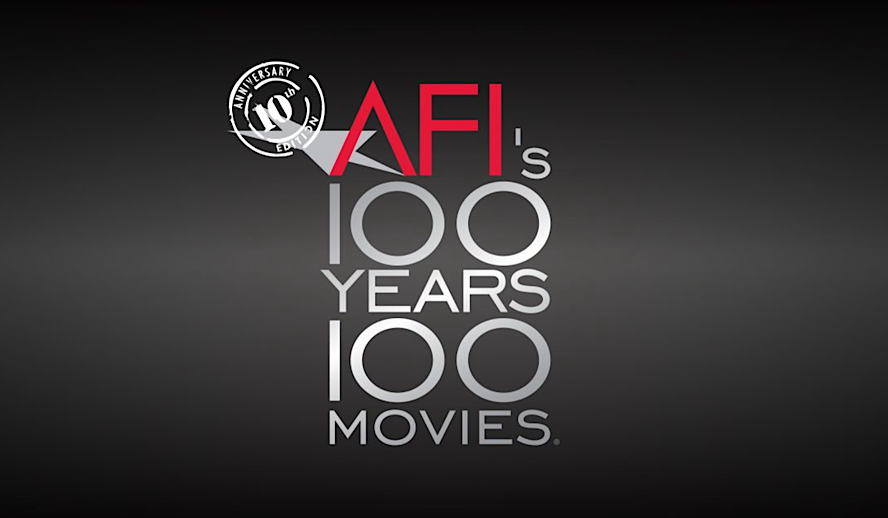Table of Contents

Video Version of this Article
Photo: AFI’s “100 Years…100 Movies”
In 2007, the American Film Institute released a revised edition of their 1998 “100 Years…100 Movies”, a historical canon of the supposed greatest American films of all time. The new list saw many films shuffle around, some skyrocketing to the top and others disappearing from the index entirely. While the catalog offers a fascinating insight into the growth of the moving picture industry from infancy to adolescence as well as a window into the prejudices of the AFI at the time with the lackluster representation of diverse talent, the top 10 films serve as an interesting microcosm of the list as a whole.
But 14 years have passed since the list was published and like many of the movies that populate it, time has raised many questions as to its accuracy, its accessibility, and ultimately, its relevance to modern movie audiences. The top 10 films span six decades and across an array of genres and motifs, but as different as they are they all share some good, some bad, and some ugly elements when held under the light of modern cinematic sensibilities.
Related article: FACT-CHECKED Series: Rock Hudson & 32 Facts on Gay Hollywood Leading Man
Ten Best American Film from AFI
10.) ‘The Wizard of Oz’ (1939), Dir. Victor Fleming (Metro-Goldwyn-Mayer)
– The Good: While not the first film released in color as many believe (that honor belongs to 1917’s disastrous ‘The Gulf Between’), Victor Fleming’s enduring 1939 classic ‘The Wizard of Oz’ proved just how big of an audience attraction color could be. When Judy Garland’s awestruck Dorothy and her little dog Toto first awakened in the vibrant land of Oz after spending the first act of the movie in the muted fields of Kansas, it was the first time many audience members ever saw such colors projected onto the movie screen. The film has endeared itself to generations of children and adults alike in its nearly 80 years of life through its elaborate sets, classic soundtrack introducing the unparalleled “Somewhere Over the Rainbow”, and indelible set of characters like the Wicked Witch of the West, The Tin Man, and the eponymous Wizard of Oz.
– The Bad: To no fault of the film, the astonishing revelation of the lush and painted Oz simply does not carry the same weight it did upon its release. As movies and the visual media industry rapidly developed, the vast majority of content audiences consumed became colorized and remastered to achieve higher qualities. With this, ‘The Wizard of Oz’ lost just a bit of its magic.
– The Ugly: Much has been made of the problematic presence of ‘The Munchkins’ in the film and the way the term quickly became a derogatory slang for people living with dwarfism. Additionally, reports later surfaced that many of the actors hired to fill the role of “The Munchkins” engaged in inappropriate behavior on the set with the crew and star Judy Garland, further complicating the legacy of the film.
Related article: MUST WATCH – Hollywood Insider’s CEO Pritan Ambroase’s Love Letter to Black Lives Matter – VIDEO
Subscribe to Hollywood Insider’s YouTube Channel, by clicking here.
9.) ‘Vertigo’ (1958), Dir. Alfred Hitchcock (Paramount)
– The Good: From the “master of suspense” himself, Alfred Hitchcock’s ‘Vertigo’ (1958) is an intricately layered labyrinth that endlessly rewards rewatch. The film opened to a largely mixed reception and was cast into the considerably small heap of supposed Hitchcock misfires, but in the decades since its release, film historians and casual fans alike have returned to the film and insisted it may actually be the best the director ever put to film. Shooting up 52 slots from the 1998 to 2007 AFI rankings and famously rising to the number one spot on the BFI’s 2012 poll and surpassing ‘Citizen Kane’ (1941), many have lauded the film in recent years for its gradually unraveling mystery and career-defining star turns from Jimmy Stewart and Kim Novak.
– The Bad: Ostensibly the lion-share of confusion and criticism the film still receives surrounds its divisive conclusion. While avoiding spoilers, the film ends in an abrupt and seemingly random rush of revelations that may very well alienate some viewers.
– The Ugly: ‘Vertigo’ has certainly aged better than some other entries on this list, but characteristic of most of Hitchcock’s work the film perpetrates and enforces the strict and demobilizing male gaze. While Novak’s Madeleine Ester certainly has more up her sleeve than most Femme Fatales of the genre, she still exists largely as an object of obsession for Stewart’s Scottie Ferguson and is often shot as such.
8.) ‘Schindler’s List’ (1993), Dir. Steven Spielberg (Universal)
– The Good: Steven Spielberg’s ‘Schindler’s List’ (1993) remains one of the foremost essential films in the history of cinema and a permanently important portrait of the unconscionable horrors of the Holocaust. The film cuts no corners and remains an unflinching dedication to the 6 million Jewish lives taken by the Nazis. There is no gray zone or possible moral ambivalence allowed within the film, and it is through Liam Neeson’s Oskar Schindler and his ultimate realization of this truth that the film is able to so masterfully convey its message. It reminds any viewer that every action in the war against hate no matter how big or small can truly make all the difference, and save the world entirely.
– The Bad: The most recent film in the list, almost nothing within ‘Schindler’s List’ feels technically dated or distracting. The only warning here surrounds the extent to which the film unwaveringly depicts the depth of inhumanity with which the Jewish prisoners were treated in the camps. It is done purposefully and accordant with history but will be deeply upsetting to any younger audience members expecting a movie closer to Spielberg’s existing filmography.
– The Ugly: Nothing at all within the film could ever be construed as ugly. The film is wholeheartedly committed to remembering all of the lives lost during the Holocaust and is near flawlessly constructed to best accomplish this goal. As such, this film represents the rare exception that proves the rule, only growing in importance with time.
Related article: Hollywood Insider’s CEO Pritan Ambroase: “The Importance of Venice Film Festival as the Protector of Cinema”
Related article: The Masters of Cinema Archives: Hollywood Insider Pays Tribute to ‘La Vie En Rose’, Exclusive Interview with Director Olivier Dahan
Related article: – Want GUARANTEED SUCCESS? Remove these ten words from your vocabulary| Transform your life INSTANTLY
7.) ‘Lawrence of Arabia’ (1962), Dir. David Lean (Horizon, Columbia)
– The Good: Possibly the preeminent encapsulation of all that the ‘epic’ genre represented, David Lean’s sprawling ‘Lawrence of Arabia’ (1962) serves as an everlasting testament to the power of cinema in elevating a story to its grandest heights. The film introduced the world to the legendary eight-time Academy Award-nominee Peter O’Toole, allowing him to explore the complicated morality of the famous war hero T.E. Lawrence. Through unprecedented striking photography of the Arabian peninsula and elaborate practical battles, the film offers viewers an experience they’ve never seen before, as well as one they will never forget.
– The Bad: Much like the next film on this list, ‘Lawrence of Arabia’ is absolutely massive. The film clocks in at around 3 hours and 47 minutes, a daunting length for many modern moviegoers. Unless it’s the likes of ‘Avengers: Endgame’ (2019), many modern audiences are not enticed by the idea of a movie passing the two-hour mark, let alone almost four.
– The Ugly: Controversy has surrounded the film as of late due to its decision to cast British Caucasian actors to portray some prominent Arabian leaders in the film. Both Alec Guinness and Anthony Quinn play characters of Arabian descent, though admittedly not done in a derogatory or discriminatory way. Nonetheless, the decision is questioned to this day.
Related article: Alfred Hitchcock’s ‘Rope’: A Masterclass in Suspense Cinema from Hollywood’s Golden Age
Related article: Keeping In Rhythm with Damien Chazelle: The Fantastically Talented Oscar Winning Director’s Movies
6.) ‘Gone with the Wind’ (1939), Dir. Victor Fleming (Metro-Goldwyn- Mayer, Selznick International Pictures)
– The Good: The film that constructed the future of the Hollywood system for decades to come, Victor Fleming’s acclaimed yet controversial ‘Gone with the Wind’ (1939) is a film that has endured several evolutions of critical consensus. Undoubtedly impressive in scope, the film employs groundbreaking camera movement and operation along with stunningly hued cinematography. The film also featured the legendary Hattie McDaniel as Mammy, the first performance by an African American actor or actress to win an Academy Award.
– The Bad: As mentioned already, ‘Gone with the Wind’ is a remarkably long film at 3 hours and 53 minutes. Additionally, the film is two distinct halves divided by a clear intermission, but the two stories are kept so different in tone that it almost feels like starting at the beginning. Most importantly, the film paints an inaccurate and deeply romanticized portrait of the ‘Old South’ prior to the Civil War. It depicts the Union “Yankees” as the clear villain and wrongfully asserts the Confederacy as the victims of encroaching Northern aggression.
– The Ugly: This film has likely aged the poorest of any on this list. It peddles in a deeply offensive and culturally insensitive narrative of slavery and supremacy that quite simply has no standing in modern culture. The white characters consistently belittle and abuse the African American characters they share the screen with and the film is heavily indicative of the age of Jim Crow racial segregation in which it was constructed.
Related article: The Top 5 Hitchcock Remakes: Analyzing the Remakes of Master Director Alfred Hitchcock’s Films
Related article: The Best Movies of EACH Decade from the 1930s Onwards
5.) ‘Singin’ in the Rain’ (1952), Dir. Gene Kelly, Stanley Donen (Metro- Goldwyn-Mayer)
– The Good: A legendary instrument of joy, Stanley Donen and star/director Gene Kelly’s magical ‘Singin’ in the Rain’ (1952) is a momentous ode to the expansive genre of American musicals and a truly unbridled explosion of singing, dancing, and heart. The film is an ingenious send-up of the vast cinematic history that preceded it, all at once a beautiful romance, lavish musical, and jocular comedy. Featuring iconic songs like “Make ‘Em Laugh”, “Good Morning”, and of course, the magnificent “Singin’ in the Rain”, this is the rare classic musical that serves as both a celebration of its time and remains ultimately timeless.
– The Bad: The film features an extended ethereal ballad continuing for a little more than 10 minutes that may cause some viewers to lose touch with the film and the characters as, despite the impressive choreography and colossal sets, the sequence does not connect to the narrative.
– The Ugly: Though brief, there is a scene towards the beginning of the film which depicts Kelly’s Don Lockwood shooting a film steeped in various regressive racial stereotypes. The scene is done in mockery of the unduly racist B-movies of the 1920s but is still insensitive.
Related article: The Early Invention of Film and Motion Pictures: An Alchemical Breakthrough | History of Movies
Related article: The Art of Deception Behind Martin Scorsese’s ‘Shutter Island’ | An In-Depth Guide & Explanation
4.) ‘Raging Bull’ (1980), Dir. Martin Scorsese (United Artists)
– The Good: Few living directors command more respect and acclaim than Martin Scorsese, and ‘Raging Bull’ (1980) remains one of his absolute greatest films. Scorsese has always had an affinity for introspective character studies, examining the likes of Henry Hill in ‘Goodfellas’ (1990) and Jordan Belfort in ‘The Wolf of Wall Street’ (2013), but never has Scorsese better illustrated the complex morals and ultimate tragedy of his lead as Robert De Niro’s Jake LaMotta. De Niro turns in a career-best performance as both a young fighter on top of the world and a washed-up comedian slowly facing the cognitive damage inflicted by his years in the ring. He is helped along by a characteristically outstanding performance by frequent collaborator Joe Pesci and a masterful debut from actress Cathy Moriarty.
– The Bad: Although not a dig on the film, ‘Raging Bull’ works in direct contradiction to the greater pantheon of boxing movies. Audiences expecting the exuberant triumph of films like ‘Rocky’ (1976) or ‘Creed’ (2015) will find a far more honest and somber experience than they bargained for.
-The Ugly: While rooted in LaMotta’s true story, the film still depicts some shocking and unpleasant domestic violence between him and his wife. As the title suggests, LaMotta’s flaming temper often causes him to explode irrationally and lash out at those in his life, specifically his wife Vickie, which is often upsetting.
Related article: Martin Scorsese: 32 Facts on the Powerful Auteur of Cinema Synonymous with Hollywood
Related article: Improvisations that Made the Final Cut: Seven Totally Unplanned Great Moments in Cinema History | Oscars Week
3.) ‘Casablanca’ (1942), Dir. Michael Curtiz (Warner Brothers)
– The Good: The seminal pillar of the romance genre, Michael Curtiz’s immortal ‘Casablanca’ (1942) is an unforgettable journey through lost love and lonely souls in the midst of the Second World War. Few star pairings have ever usurped the duo of Humphrey Bogart and Ingrid Bergman as misanthropic nightclub owner Rick Blaine and the one that got away, Ilsa Lund. The film builds the two out as starkly independent forces with the faint suggestion of history between them before revealing the true tragic love story that lies at the film’s core. The film beautifully conveys that no matter how hard it got for the pair, and the many millions who so lovingly return to the film every year, they would always have Paris.
– The Bad: This film is helmed by a very tight and circular screenplay and there is very little in the way of plot holes or thematic deadends once it has reached its conclusion. Some knowledge of the time period is assumed, however, so while it is minimal, one might want to understand the context of World War II on the continent of Africa.
– The Ugly: The only possible area of contention with ‘Casablanca’ lies within the morality of Bogart’s Rick Blaine. Time and time again, the character insists that he wants no part of the war nor does he care about the crimes of the Nazis, focusing solely on his club and its guests. While not an endorsement of the Nazi’s affairs, it remains an immoral passive acceptance of them.
Related article: Documentary – ‘They’ll Love Me When I’m Dead’: Orson Welles’s Efforts to Finish His Passion Project
Related article: Worst Oscar Snubs: The Academy Awards Failed By Ignoring These Great Movies and Performances
2.) ‘The Godfather’ (1972) Dir. Francis Ford Coppola (Paramount)
– The Good: The de facto answer for “greatest film of all time” for many modern moviegoers, Francis Ford Coppola’s unassailable masterwork ‘The Godfather’ (1972) is quite possibly the highest height cinema has yet to reach. Featuring a script so steeped in spiritual symbolism and ripe with iconography it is still being unpacked 50 years since its release, the film looms large above nearly every other production in its wake. The film sees all of its actors hitting the peak of their cinematic powers; Al Pacino as the restrained and tortured black sheep turned savior of the Corleone crime family, James Caan, Robert Duvall, Diane Keaton, and John Cazale serve as exemplar cogs in the movies machinery, and of course Marlon Brando’s unrivaled portrayal of Don Vito Corleone. There has been a lot said about Coppola’s crowning achievement, possibly more than any other film, but as the years go on it is likely that it will never be enough to capture it in its truest glory.
– The Bad: There is next to nothing in ‘The Godfather’ that could come close to the categorization of ‘bad’ or ‘unnecessary’. Each scene flows seamlessly into the next until the bigger picture starts to reveal itself. There is a brief segment of the movie where the Michael character goes off on a separate journey from the rest of the cast that may seem at first disjointed, but this is quickly smoothed over and only serves to better the film in the end.
– The Ugly: Similar to the above category, with a film as technically and structurally perfect as ‘The Godfather’ there is very little that stands out negatively with time. The movie is undoubtedly incredibly violent, as characteristic of the gangster genre as a whole, but the violence is done with such clear purpose and intentionality that it too only aids the film and its legacy.
Related article: Top 10 Best Gangster Movies, Ranked, from ‘Scarface’ to ‘The Godfather’
Related article: Remembering Sidney Lumet’s Forgotten Masterpiece ‘Network’: After 45 Years of Persistent Premonition, Predication, and Proliferation
1.) ‘Citizen Kane’ (1941), Dir. Orson Welles (RKO)
– The Good: And at last, the list comes to a close with Orson Welles’ ‘Citizen Kane’ (1941). Never far from the top three or four spots in most professional all-time rankings, the film has grown into somewhat of an untouchable landmark, an emblematic representative of the art of moving pictures. Coming from the most sought-after name in Hollywood at the time, Orson Welles’ very first credit demanded a herculean effort to make sure every possible aspect of the film rose to his unprecedented ambitions.
Welles wound up serving as the film’s director, producer, star, and writer (though this credit is contested to this day, as discussed in David Fincher’s 2020 Netflix original ‘Mank’), and for all that he put into the film, it gave much more back to him in the years to follow. While not instantly held as the greatest film of all time, only winning a singular Academy Award for its screenplay, the film developed a reputation as a stroke of genius from one of the greatest minds in Hollywood. Through its nonlinear storytelling and absorbing central mystery, the film has unceasingly amazed generations, ultimately earning its spot at the top of the AFI’s list and cementing itself as a beautiful snapshot of the human condition.
– The Bad: Much like ‘The Godfather’, it is hard to say anything is “bad” within the film. The fast editing, de-emphasis on establishing a concrete sense of place outside of Xanadu Castle, and largely unlikeable characters which alienated some audiences upon its release and then later fascinated countless crops of film historians may have come full circle, causing more casual viewers to pull away from the film as it goes against normal narrative storytelling. This is not a fault of the movie, it is in fact its greatest strength, but it’s more an interesting evolution of cinematic interests and attention spans.
-The Ugly: Much of the celebratory acclaim ‘Citizen Kane’ has amassed over the years stems from its apparent timelessness as a critique of both the mountaintop highs and cavernous lows of capitalism and as such, the film holds up remarkably well. The central question surrounding just how far money can really take someone is endlessly fascinating and will forever have audiences searching for a “rosebud” of their very own.
Still reading? Well its time to get watching.
Click here to read Hollywood Insider’s CEO Pritan Ambroase’s love letter to Black Lives Matter, in which he tackles more than just police reform, press freedom and more – click here.
An excerpt from the love letter: Hollywood Insider’s CEO/editor-in-chief Pritan Ambroase affirms, “Hollywood Insider fully supports the much-needed Black Lives Matter movement. We are actively, physically and digitally a part of this global movement. We will continue reporting on this major issue of police brutality and legal murders of Black people to hold the system accountable. We will continue reporting on this major issue with kindness and respect to all Black people, as each and every one of them are seen and heard.
Just a reminder, that the Black Lives Matter movement is about more than just police brutality and extends into banking, housing, education, medical, infrastructure, etc. We have the space and time for all your stories. We believe in peaceful/non-violent protests and I would like to request the rest of media to focus on 95% of the protests that are peaceful and working effectively with positive changes happening daily. Media has a responsibility to better the world and Hollywood Insider will continue to do so.”
Ways to support Black Lives Matter Movement to end systemic racism
More Interesting Stories From Hollywood Insider
– Want GUARANTEED SUCCESS? Remove these ten words from your vocabulary| Transform your life INSTANTLY
– Compilation: All James Bond 007 Opening Sequences From 1962 Sean Connery to Daniel Craig
– Do you know the hidden messages in ‘Call Me By Your Name’? Find out behind the scenes facts in the full commentary and In-depth analysis of the cinematic masterpiece
– A Tribute To The Academy Awards: All Best Actor/Actress Speeches From The Beginning Of Oscars 1929-2019 | From Rami Malek, Leonardo DiCaprio To Denzel Washington, Halle Berry & Beyond | From Olivia Colman, Meryl Streep To Bette Davis & Beyond
– In the 32nd Year Of His Career, Keanu Reeves’ Face Continues To Reign After Launching Movies Earning Over $4.3 Billion In Total – “John Wick”, “Toy Story 4”, “Matrix”, And Many More
afi, afi, afi, afi, afi, afi, afi, afi, afi, afi, afi, afi, afi, afi, afi, afi, afi, afi, afi, afi, afi, afi, afi, afi, afi, afi, afi, afi, afi, afi, afi, afi, afi, afi, afi, afi, afi, afi, afi, afi, afi, afi,

Andrew Valianti is a writer and an aspiring producer-director, and all-around film lover. While writing both features and reviews for the Hollywood Insider, Andrew has focused on the intersection of cinema and politics as they relate to empowering diverse stories and viewpoints. Through both study and practice, Andrew has seen first hand the many ways in which film and media can have a positive and meaningful impact on everyday lives. His personal views align with the Hollywood Insider, as he views journalism as a means to empower and mobilize positive change rather than spread gossip or negativity. He believes that art ignites action and has sought to pursue stories that further this goal.








